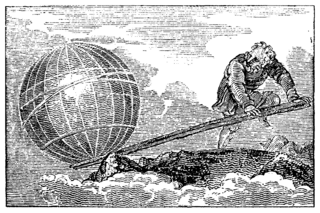Earth mass facts for kids
Quick facts for kids Earth Mass |
|
|---|---|
|
An old drawing showing Archimedes' famous idea: "Give me a place to stand, and I will move the Earth."
|
|
| General information | |
| Unit system | astronomy |
| Unit of | mass |
| Symbol | M⊕ |
| Conversions | |
| 1 M⊕ in ... | ... is equal to ... |
| SI base unit | (5.9722±0.0006)×1024 kg |
| U.S. customary | ≈ 1.3166×1025 pounds |
The Earth mass (M⊕) is a special unit of mass that is exactly equal to the mass of our home planet, Earth. Imagine how heavy the Earth is! One Earth mass is about 5,972,190,000,000,000,000,000,000 kilograms. That's a 5 with 24 zeros after it! Scientists use Earth mass to describe how heavy other rocky planets are, especially those that are similar to Earth.
For example, the other three rocky planets in our Solar System are Mercury, Venus, and Mars. Mercury is much lighter, at about 0.055 Earth masses. Venus is almost as heavy as Earth, at 0.815 Earth masses. Mars is lighter than Earth, with a mass of about 0.107 Earth masses. Using Earth mass makes it easier to compare these planets without using huge numbers of kilograms.
Contents
What is Earth Mass?
The Earth mass (M⊕) is a way for scientists to measure how much "stuff" is in a planet. It's like saying, "This planet weighs as much as 0.8 Earths" instead of using a giant number in kilograms. This unit is super helpful when talking about planets that are similar to Earth, which we call terrestrial planets. These are planets made mostly of rock or metal, like Earth, Mars, Venus, and Mercury.
Why Do We Use Earth Mass?
Using Earth mass as a unit makes it simple to compare the sizes and weights of different planets. Imagine trying to remember numbers like 5,972,190,000,000,000,000,000,000 kg for Earth and 641,690,000,000,000,000,000,000 kg for Mars. It's much easier to say Mars is about 0.107 Earth masses. This unit helps astronomers quickly understand how big and dense a newly discovered planet might be compared to our own.
How Scientists Measure Earth's Mass
Measuring the Earth's mass isn't like putting it on a giant scale! Instead, scientists use the laws of gravity. They look at how strongly the Earth pulls on other objects, like the Moon or satellites orbiting our planet. By understanding how gravity works and how fast things fall towards Earth, they can calculate its mass.
The Role of Gravity
Isaac Newton's law of universal gravitation helps us understand how objects attract each other. The stronger the gravitational pull, the more massive the objects are. Scientists use very precise tools to measure the strength of Earth's gravity in different places. These measurements, combined with the Earth's size and how it spins, help them figure out its total mass.
Comparing Planets Using Earth Mass
The Earth mass unit is especially useful for comparing rocky planets.
- Mercury: This small planet is only about 0.055 times the mass of Earth. It's the smallest planet in our solar system.
- Venus: Often called Earth's "sister planet," Venus is very similar in size and mass. It's about 0.815 Earth masses.
- Mars: The "Red Planet" is much smaller than Earth, with a mass of about 0.107 Earth masses.
This unit helps us see at a glance how different these planets are in terms of their overall "heaviness."
Images for kids
See also
 In Spanish: Masa de la Tierra para niños
In Spanish: Masa de la Tierra para niños



